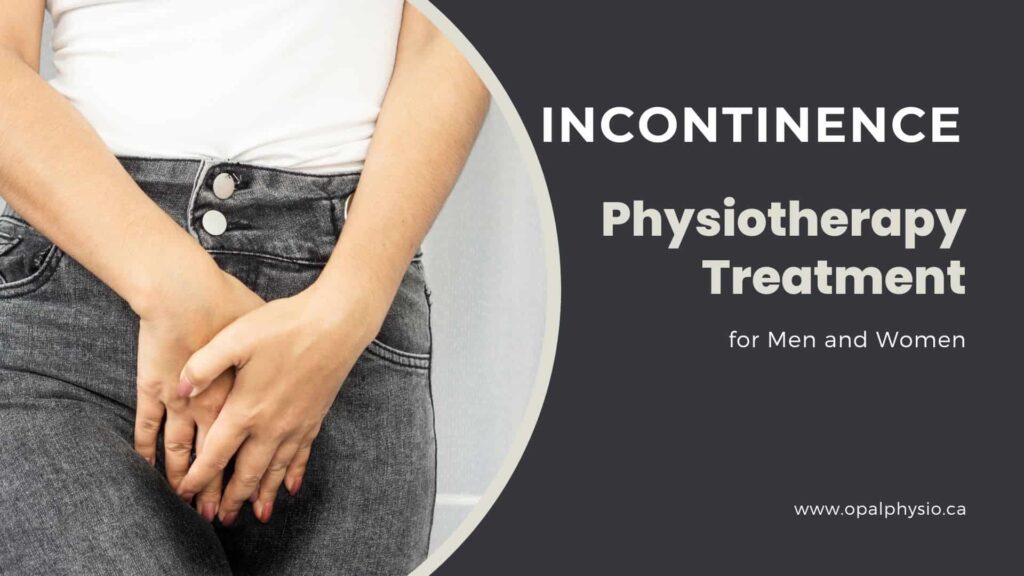Incontinence Treatment for Men and Women
Incontinence is a common problem that affects millions of people around the world.
Whether you’re a man or a woman, It can be frustrating and embarrassing, significantly impacting your quality of life. That’s why we offer specialized incontinence treatment for both men and women, designed to help you regain bladder control.
Our compassionate and skilled pelvic floor physiotherapists in Langley are dedicated to providing personalized, evidence-based treatment plans to help you retrieve control, confidence, and comfort.
We aim to empower you with the knowledge and tools to manage and overcome voiding accidents, allowing you to lead a more active and fulfilling life whether you are experiencing urinary or fecal incontinence.

Incontinence
Incontinence is the unintentional loss of urine or feces. It can affect men and women and occur at any age, but it is more common in older adults and significantly limits their social life.
Causes may differ for men and women and can be related to other health problems or life events, such as prostate problems or pregnancy.
Unfortunately, many do not seek intervention due to embarrassment or lack of awareness of the treatment alternatives. But the good news is that physiotherapy is the preferable simple, effective treatment option.
Types of Incontinence
Incontinence can be urinary (bladder) or fecal (bowel) incontinence.
Urinary incontinence
Urinary incontinence is the unintended discharge of urine. Studies have proven it is common in women because of bladder malfunction and pelvic floor muscle weakness following pregnancy and delivery. However, prostatic enlargement or disruption can cause voiding problems in men following prostate cancer surgery or radiotherapy.
This medical condition poses a significant risk to mental health, thus lowering the quality of life.
Risk factors of urinary incontinence:
- Age: The chances of having urinary leakage increase with age. Your pelvic floor muscles weaken as you grow older.
- Body mass index: Increased body weight causes a rise in intra-abdominal pressure, which affects continence. Weight reduction can lead to a notable improvement in your urinary leakage symptoms.
- Recurrent urinary tract infection (UTI): Frequent UTIs and treatment of urinary tract infections will jeopardize the function of your bladder, increasing the risk for involuntary leaks.
- Parity: A multiparous woman is more likely to develop urinary leakage issue than a nulliparous lady.
- Mode of delivery: Vaginal delivery can cause excess strain on the pelvic floor muscles.
- Size of the baby: Overweight fetus adds excess pressure to the pelvic muscles.
- Other medical conditions: Studies have shown that diabetes, stroke, multiple sclerosis and depression are associated with a high risk of involuntary urination.
- Stress and anxiety can also increase the risk of developing urinary leaks.
Types of urinary incontinence:
You can present with over one type of voiding issue. For instance, stress and urge incontinence might disguise as an overactive bladder and getting a consultation is essential to address your issues.
Clinical symptoms of urinary incontinence:
- Leakage of Urine: This is involuntary urine loss.
- Frequent urination: Normal urine frequency varies from person to person based on personality factors, bladder capacity, and fluid intake routines. Interpreting a urinary frequency routine can be challenging, but significant differences in the frequency of urination can mean that this needs to be addressed.
- Urinary Urgency: It can happen with or without leakage but often leads to incontinence. With frequent lower urinary tract infections or inflammation, the urge to urinate may persist, even though you may void only a few quantities of urine each time.
- Nocturia: Is characterized by waking up often at night to urinate.
- Prolapse: Weak pelvic floor muscles can cause the organs like the uterus, urethra or bladder to prolapse into the vagina and may cause urinary issues.
Bowel incontinence
Bowel (Fecal) incontinence is the unintended loss of feces and gas via the anal canal and the incapability to postpone the evacuation until it is more convenient. The severity can range from a reflexive passage of flatus to the total evacuation of fecal matter.
Causes of bowel (fecal) incontinence:
- Trauma: Vaginal delivery, mediolateral episiotomy, anal penetration, or sexual abuse can reduce the optimal function of your bowel or pelvic floor muscles.
- Surgical procedures: Invasive procedures such as anorectal operation, hemorrhoidectomy, colorectal operation, or low anterior resection can threaten bowel function.
- Neurogenic: Multiple sclerosis, stroke
- Metabolic: Type 1 or type 2 diabetes mellitus.
- Congenital deformity: These birth anomalies include spinal Bifida or lumbar-sacral spinal deficiencies.
- Other conditions: Aging, dementia, laxative abuse, constipation, large hemorrhoids, bowel disease, or anorectal inflammation can cause bowel leakages.
Symptoms of bowel incontinence:
The signs and symptoms are
- Uncontrollable loss of fecal material or defecation.
- Complaint of additional bowel issues, such as diarrhea, constipation, gas, and bloating.

Physiotherapy can help treat your incontinence:
A pelvic floor physiotherapist is irreplaceable in treating urinary and bowel incontinence. A physiotherapy assessment will give a precise diagnosis of the type of incontinence. Your physiotherapist will assess you subjectively (history taking) and objectively (standard measurement) to help diagnose. The clinical examination also involves two vital measurements; pelvic floor muscles function and strength measurement.
The physiotherapist will perform an external assessment and internal palpation of the pelvic floor muscles to check for strength, prolapse and muscle tenderness. Your pelvic floor function and strength measurement require a Modified oxford grading system and PERFECT approach.
The pelvic floor physio treatment aims to improve pelvic floor muscle strength and function to enhance control over the symptoms, encourage and maintain a healthy lifestyle, reduce the need for surgery, reduce the use of incontinence pads and improve life quality.
Your diagnosis determines the physiotherapy treatment plan, which may include the following:
- Pelvic floor muscle training: Kegels’s is a form of pelvic floor muscle training exercises. The physiotherapist will prescribe and direct you on how best to do the pelvic floor muscle exercise.
- Core muscle training
- Breathing techniques
- Bladder retraining
- Behavioural retraining: Your physiotherapist provides education to help you maintain a healthy lifestyle and bowel regulation combined with fluid or diet management.
- Biofeedback and Electrical Stimulation
- Real-time ultrasound for biofeedback
Pelvic floor physiotherapy is a practical treatment approach for incontinence. At Opal Physiotherapy, our pelvic physiotherapists offer various treatment approaches, including education on lifestyle modifications, pelvic floor muscle rehabilitation, and manual therapy to address the underlying causes and issues. Contact us today to determine the best course of action for your urinary problem.
